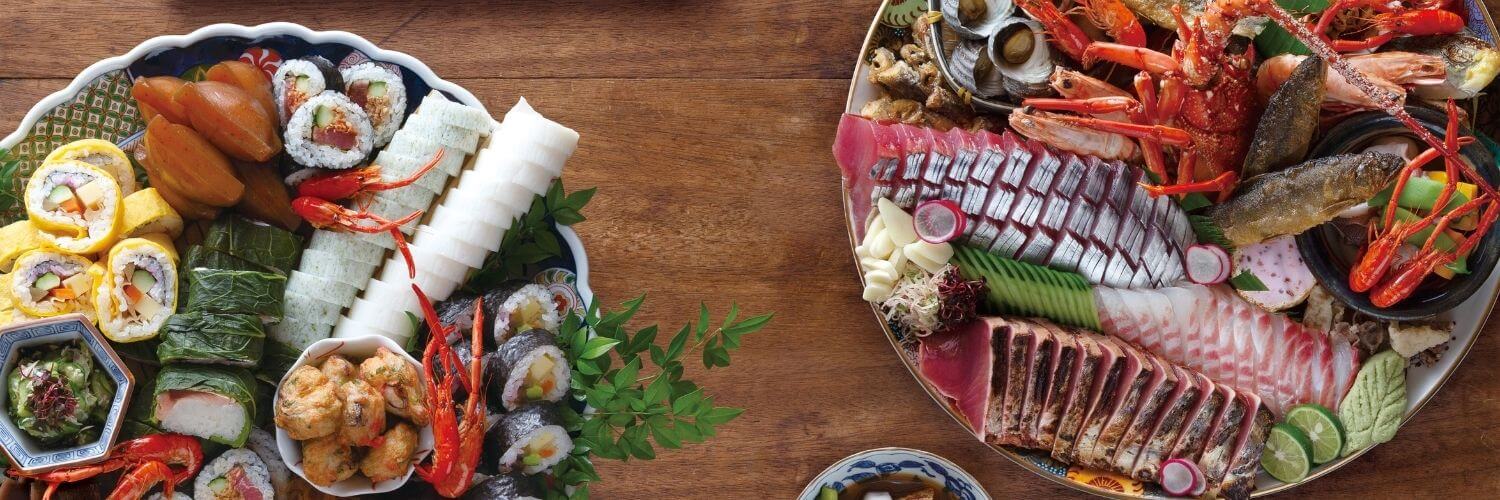
Destination, Food Travel, Kochi, Local Flavor
Tosa Dish: A Hidden Treasure from Kochi Prefecture
8 minutes
Tosa Dish is the regional food of Kochi Prefecture. From Katsuo No Tataki (seared skipjack tuna) to Sawachi Ryori (platter full of local delicacies), discover the unique flavor of Kochi.
Mountains to the north, hugging the Pacific Ocean to the south. Japan’s Kochi prefecture, formerly known as Tosa province, is blessed with an abundance of nature. Green forest covers 84% of the prefecture, making Kochi the greenest place in Japan. Due to the perfect location, with ample sunshine and rainfall, Kochi has the ideal climate to cultivate gourmet ingredients. Because of this, Kochi is one of the agricultural powerhouses of Japan.
Great ingredients mean great food. Naturally, Kochi prefecture has its own food culture that’s rooted in its people. Tosa-jin, the people of Tosa (Kochi), pride themselves on their local cuisine. Their “merry community mindset” cherishes dining and drinking together. Gather around a large table and eat delicious food that makes people smile. A smile IS the secret ingredient that makes Tosa Dish, the food of Kochi prefecture, unique.
What is Tosa Dish (Tosa Ryori)?

Tosa Dish (Tosa Ryori) is a little-known treasure that attracts gastronomes from around the world. Tosa Dish isn’t about one specific dish, but it refers to the regional food as a whole. The most popular Tosa Dish is “Katsuo no Tataki.” It’s a slightly seared bonito (skipjack tuna) usually served with ginger and ponzu sauce. Another unique dish is “Sawachi Ryori,” a large platter filled with local delicacies of Kochi.
The term “Tosa Dish” was first introduced in 1969 by Kazuo Takeuchi, the then-owner of a restaurant called “Tosa Ryouri Tsukasa” in Kochi, to brand the cuisine from the area to other parts of Japan. Serving quality food using only the best ingredients since 1917, Tsukasa has made its name synonymous with “Tosa Dish” and now has 12 restaurants in Kochi, Osaka, and Tokyo. Umami Insider had the honor of speaking with the Executive Chef of Tsukasa, Chef Ito, to explore the beauty of Tosa Dish.
Tosa Dish, Explained by Chef Ito of Tsukasa

Trained in traditional Japanese Kaiseki, Chef Ito devoted his career mastering the art of Tosa Dish. According to him, Tosa Dish is a combination of tradition, vibrant colors, and fresh ingredients. “Knowing the good and bad of each ingredient is the key,” says Chef Ito. “It’s important to make the most of the original flavor of the ingredients. It’s also important to think about the shape of the ingredients. We avoid mashing or breaking them, but we keep the original shape when creating a plate. It’s about going beyond the cooking techniques and quality ingredients. It’s really about knowing how to make the best out of each ingredient.”
“Japanese cuisine in general, including Tosa Dish, it’s different from other cuisines. We don’t have the custom to add a final touch to the dish with various sauces. It’s about simplicity. But you know, making a simple but good dish isn’t easy. It takes craftsmanship and experience.”
“Salt itself makes a huge difference,” he continues. “For seafood, use sea salt. For vegetables, use rock salt (salt from the mountain).” However, sometimes it’s also important not to use too much seasoning when cooking. “You need to know when to use seasoning (dashi stock, etc.) and when to enhance the natural flavor and scent of the ingredient without seasoning it.”
Fresh Ingredients At the Core
At Tsukasa restaurant, sourcing the freshest ingredients is extremely important. Sometimes, the chef himself even goes to the market to evaluate the quality of produce and seafood. A variety of seasonal ingredients are available in Kochi, from its vast mountains, warm and salty Kuroshio current of the Pacific Ocean, and crystal clear rivers. Here are some of Chef Ito’s favorite ingredients from the beautiful prefecture of Kochi.

The Mountains
Eggplant
When cooking with eggplant, it’s essential to make long and shallow incisions on the skin side of the eggplant. These incisions will make eggplant soak flavor better and cook faster. Eggplant and oil go well together. Cut eggplant into small pieces, pour plenty of olive oil, and mix with dashi powder. Cover and microwave for 3 minutes (500W). Place the eggplants on top of your salad and enjoy with ponzu sauce.
Shiho-Chiku (Bambooshoot)
Shiho means square, and Chiku means bamboo shoots in Japanese. This kind of bamboo shoot got its name because it has a “square shape” when sliced in half. Shiho-chiku can only be harvested in October, and it’s a delicious ingredient to make a steamed dish or tempura.
Genboku Shiitake
You can forage a variety of vegetables in the mountains of Kochi. One of the traditional local dishes of the mountainside of Kochi is a fried genboku shiitake dish. All you need to do is cover the shiitake in katakuri powder and fry it in vegetable oil. Top your salad with fried shiitake with plenty of ponzu sauce.
Naoshichi Sudachi

Naoshichi sudachi is a secret ingredient that makes Tsukasa’s Tosa Dish tastier. It is a rare citrus fruit that can only be cropped between September and October. Because of the low production rate, the fruit is rare even in Japan. The flavor is mellow and less sour than lemon or yuzu citrus, with a fresh scent and a slightly bitter aftertaste. It’s a perfect ingredient to add a subtle citrus flavor to your dish.
The Rivers
Aosa
Aosa is a type of seaweed. Kochi prefecture is blessed with crystal clear rivers, and the most famous of all is the Shimanto River. It’s considered the last free-flowing clear water river of Japan. Shimanto’s aosa is getting rarer and rarer. It’s highly fragrant, and to conserve the delectable scent, the best way to cook aosa is by frying or in soup. Aosa becomes more fragrant by being introduced to the heat.
Ayu (Freshwater Trout) and Unagi (Eel)
Another famous river of Kochi prefecture, the Niyodo River, is home to plenty of fresh river fish like trout and eel. At Tsukasa, Chef Ito uses these fish to make a delicious menu often included in “Sawachi Ryori.”
Gori (Japanese Sculpins) and Tenaga-Ebi (Freshwater Prawns)
A fresh river is also an excellent place for small fish like Gori and Tenaga-Ebi (freshwater prawns). These are great ingredients to make karaage (deep-fried dish) or tsukudani, a savory dish simmered in soy sauce and mirin.
The Ocean
Utsubo (Moray Eel)
Utsubo isn’t a typical fish you would find at a restaurant in Japan. It’s a local delicacy of the Tosa region. Chef Ito describes the texture as “gelatinous and chewy.” If he can source the fresh utsubo, he can make it into sashimi, and it tastes like pufferfish, one of the most expensive delicacies of Japan. When baked, it has a similar texture as chicken. When in Kochi, you should try eating moray eel!
Katsuo (Skipjack Tuna, bonito)


You cannot talk about Tosa Dish without Katsuo. It’s one of the most popular dishes people associate with Tosa Dish. At Tsukasa, sourcing the best and freshest katsuo is essential. They only use katsuo fished by Japan’s “Ippon-Zuri” fishing method. It’s a method that uses a single rod and line that requires years of experience. It also is a sustainable way to catch katsuo without damaging the flesh.
Katsuo No Tataki, A King of Tosa Dish
You must eat Katsuo No Tataki when you’re in Kochi prefecture. According to Chef Ito, this dish covers all of the five elements of taste, and that’s why it’s delicious.
Five Taste Elements of Katsuo No Tataki
- Sweetness: Katsuo contains a lot of amino acid that gives you a sweet flavor. Heating up enhances the taste of amino acids.
- Bitterness: By burning the surface just enough adds fragrant bitterness.
- Saltiness: Sprinkling salt removes the “distinct smell” of katsuo.
- Sourness: Garnishing it with ponzu sauce is a perfect way to add extra flavor.
- Umami: Katsuo (bonito) is the main ingredient of dashi stock, the core flavoring agent of Japanese cuisine.
Naturally, it contains a robust umami flavor.



At Tsukasa restaurant, the cooking technique is as pristine as the fish’s freshness. Traditionally, katsuo no tataki is cooked by smoking in the burning straw. “Smoking makes katsuo no tataki too smokey, and it also adds blackness to the fish,” says Chef Ito. “They do that to cover the natural stinky-ness of the fish itself. But since our katsuo is fresh and we remove the smell of katsuo with salt during the preparation, we don’t need to mask the scent of katsuo with smoke.” Instead, at Tsukasa, the chef uses charcoal fire. This cooking method enables the fish to heat up to 1000 degrees Celsius (1832 F) fast, and the infrared radiation makes the skin of the fish extra crispy and the inside soft. “We do add straw at the very end to add a subtle scent to boost the umami,” Chef Ito shares the secret.
Sawachi Ryori, A Charm of Tosa Dish
Sawachi Ryori is a large platter full of dishes using flavorful ingredients of Tosa meant to be shared with your friends and family. The people of Tosa, Tosa-jin, are known to be happy and full of hospitality. They even have a culture of “Okyaku,” which means “to party” in the Tosa dialect. Sawachi Ryori represents the charming nature of Tosa-jin, and it showcases menus made with ingredients from the mountains, the rivers, and the Pacific Ocean.


The only rule when making Sawachi Ryori “is not to follow any rules,” says Chef Ito. It’s all about creating a large platter full of vibrance and color. You’ll often find a bright red spiny whole lobster in the center of the platter. Surrounding the centerpiece, you’ll have a variety of fried or steamed dishes alongside sushi and sashimi. It’s a platter that includes everything that’s in season, and because it’s so grand, sometimes Sawachi Ryori is referred to as “master art of Japanese cuisine.”
Experience Tosa Dish
When you are in Japan next time, visit Kochi prefecture to experience the depth of Tosa food culture yourself. Restaurant Tsukasa has multiple locations in Tokyo and Osaka if you don’t have enough time to extend your trip to Kochi. Chef Ito oversees every single location of Restaurant Tosa Ryouri Tsukasa, ensuring you get the best food at whichever Tsukasa location you dine.
And for those of you who don’t have a specific plan to visit Japan soon, you can now enjoy some of the leading ingredients from Kochi prefecture at home. Check out our online store and start cooking! We also partnered with Chef Hiroyuki Terada, a master sushi chef living in Florida. He is originally from Kochi prefecture, and he’ll show you how to make tataki using NY strip steak with Tsukasa’s ponzu, naoshichi juice, and Muroto deep seawater salt. Check out his YouTube video here. If you are more interested in sourcing fresh produce from Kochi for your business, you can find more details from the official website.
